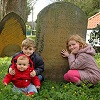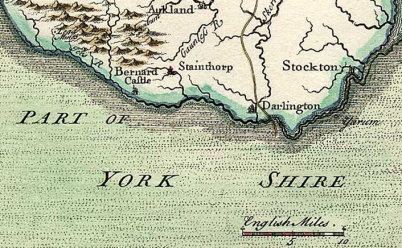I’m currently living and working in the city of Bristol in south west England. With a few notable exceptions, my paternal ancestors are all from the north east, so I was surprised to discover that a four-times great grandparent was born in my adopted city.
⁂
My great-great-great-great grandfather Cornelius Sadler was baptised on Tuesday, 9 December 1794, at Holy Cross church in the parish of Temple, which lay in the part of Bristol south of the River Avon, in the historic county of Somerset. Cornelius’s father was also called Cornelius (a Biblical name which became popular in England from the 16th century onwards, possibly through Dutch influence); his mother was Ann.1
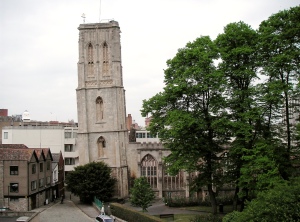
The ruins of Temple Church, Redcliffe, Bristol. ‘The Leaning Tower of Bristol’, its west tower has leaned 2.7° away from the vertical ever since its initial construction on soft clay in the 15th century. © Copyright Matt Gibson and licensed for reuse under this Creative Commons Licence.
Temple Church was reduced to a ruin by the Luftwaffe on the night of 24 November 1940, when it took a direct hit from an incendiary bomb during the Bristol Blitz. The parish registers stored within the church were damaged by fire and by the water used to quell the flames, and the church itself was left an empty shell which is now a Grade II* listed monument.
While the original, damaged Temple parish registers (held at Bristol Archives) are not in a fit state for production, luckily the Diocese of Bristol’s transcripts of the records for the years including the baptism of my four-greats grandfather have been microfilmed.
⁂
On 13 March 1815, one Cornelius Sadler married Mary Harper at All Saints’ Church, Newcastle upon Tyne. Cornelius and his bride are both described as “of this parish” (i.e. at the time of their marriage they both lived in the parish of Newcastle All Saints, which included the eastern part of the city of Newcastle as well as the township of Byker on the other side of the Ouseburn Valley).2
Later records confirm that this is ‘my’ Cornelius Sadler, born in south Bristol in 1794. So far I have found no records that might help to explain what had brought him to a city hundreds of miles away from his birthplace, nor any definite further trace of his father, Cornelius Sadler senior, in Bristol* or elsewhere.
(*There is a record of a marriage of a Cornelius Sadler to an Elizabeth Bryant at St Nicholas’ Church, Bristol, in December 1810, but at the moment I have nothing to tell me whether this is a second marriage of Cornelius senior, a very early first marriage for Cornelius junior—he would have been only 16 years old at the time—or that of an unrelated person with the same, surprisingly common, name. More research needed.)3
⁂
Back in the north east, Mary Harper and Cornelius Sadler had seven children:2,4
- Mary, baptised 3 December 1815, Newcastle All Saints (N.A.S.)
- Isabella, b. 25 July 1818; bapt. 28 January 1821, N.A.S.
- James, bapt. 28 January 1821, N.A.S.
- Cornelius [III], b. 22 December 1822; bapt. 12 January 1823, N.A.S.
- Anne Charlotte, bapt. 21 January 1825, N.A.S.
- Tamar, bapt. 18 November 1827, N.A.S. – d. 1836 (aged 8)
- Thomas Mark, bapt. 22 September 1833, Aycliffe, County Durham
On their childrens’ baptism records the family are recorded as living in the Ouseburn area of east Newcastle – save their youngest child Thomas Mark Sadler, who was baptised in County Durham while the Sadlers were living in the village of Brafferton.4
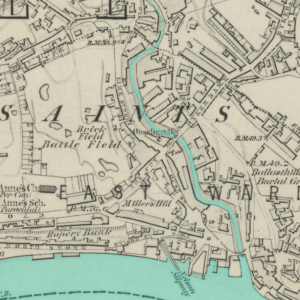
Map of Ouseburn, Newcastle upon Tyne.
Ordnance Survey six-inch map of Northumberland (sheet XCVII), 1864. Reproduced with the permission of the National Library of Scotland. (The image has been edited and the River Tyne and Ouseburn River coloured blue for clarity.)
By the time of the 1841 census of England, the 47-year-old Cornelius, his wife Mary, and five of their seven children were back in Newcastle and living in Jesmond Vale, further up the Ouseburn Valley. Reflecting their baptism records, only Cornelius and his son (Thomas) Mark are enumerated in this census as not having been born in the county of Northumberland.5 Ten years later, the census return for 1851 confirms that Cornelius’s birthplace was Bristol.6
In both censuses and at all of his children’s baptisms, Cornelius was described as a flax dresser. This job involved separating and preparing the coarse fibres of flax or hemp with a tool called a heckle, so that it could be spun into linen fabric by weavers like my own Stainthorp ancestors. (This is also the origin of the verb ‘to heckle’ meaning for a member of an audience to shout derisory or disruptive comments at the speaker.)
My four-greats grandfather Cornelius Sadler died on 6 March 1857, at or near his home, in Stepney Bank, Newcastle. He was 63 years old.7,8
⁂
My three-greats grandfather was Cornelius’s fourth-eldest child and namesake, Cornelius Sadler [III] (1822-1882). He was a blacksmith, grocer and provision dealer, working out of premises on Lime Street, Ouseburn, for more than thirty years.8–12
This younger Cornelius married Jane Dixon Hall in Newcastle in 1844;13 they had ten children (five boys and five girls) including:
- A son, Cornelius Sadler [IV] (1848-1909) – he became a blacksmith like his father and was the last to bear the name ‘Cornelius’ in this direct line, though the name crops up again in several collateral lines (i.e. nephews and grand-nephews); there are also separate dynasties of Sadlers in which Cornelius was a popular forename – in Wolverhampton, Sheffield, and Norfolk/Suffolk.
- Identical twin boys, Mark Harper Sadler and Thomas Leighton Sadler, born 13 May 1855. M. H. Sadler (the elder twin by twenty minutes) was a real ‘local worthy’—serving as a member of the South Shields Board of Guardians, as an Alderman on the South Shields Town Council, as the representative for that town on the North-Eastern Sea Fisheries Committee, and as chairman of the South Shields Institute for the Blind and Blind Persons Act Committee—and a successful local businessman, as was his twin brother. In 1935 the twins celebrated their 80th birthday in South Shields; a family photograph taken on that occasion records a huge gathering of the surviving Sadler siblings along with dozens of children, grandchildren, etc. Mark Harper Sadler also wrote a very comprehensive ‘Chronicle of the Sadler family‘ in 1901, which has been very useful in confirming details of the bewildering number of Sadler cousins…14
- A daughter, Annie Sadler, who ran a grocer’s shop in her own right before marrying currier Thomas Edward Heslop in 1894.13,15 Their own daughter, Jane Sadler Heslop, was my great grandmother. During WWI she was employed at the Armstrong-Whitworth engineering works in Elswick on the banks of the Tyne, and she was a keen musician, singer and amateur dramatist. Jennie Sadler Heslop married my great grandfather David Gray in Gosforth in 1921.16 She passed away in May 1979, just a couple of months after I was born.17
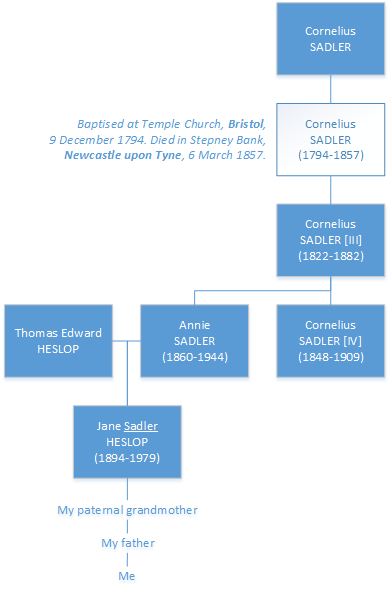
Sketch family tree of the Sadler family
showing four generations named Cornelius.
⁂
Thanks to Bristol Archives and to the Bristol & Avon Family History Society for their assistance with local records.
Paul Harland Stainthorp (paul@paulstainthorp.com).
Version 1.0, updated 9 September 2018.
References
- Temple Church (Bristol, Somerset, England), bishop’s transcripts, microfiche, Bristol Archives.
- The Church of Jesus Christ of Latter-day Saints, “England, Durham Diocese Bishop’s Transcripts, 1639-1919”, digital images, FamilySearch, https://www.familysearch.org/ ; citing Durham University Library.
- St Nicholas’ Church (Bristol, Gloucestershire, England), parish registers, microfiche, Bristol Archives.
- The Church of Jesus Christ of Latter-day Saints, “Parish registers for Aycliffe, 1560-1919”, digital images, FamilySearch, https://www.familysearch.org/ ; citing Durham County Record Office.
- “1841 England Census”, digital images, Ancestry Library Edition, http://www.ancestrylibrary.com/ ; citing The National Archives, Kew.
- “1851 England Census”, digital images, Ancestry Library Edition, http://www.ancestrylibrary.com/ ; citing The National Archives, Kew.
- England and Wales, “GRO Online Index”, database, General Register Office, https://www.gro.gov.uk/ .
- Newcastle Journal, “British Newspapers 1710-1963”, digital images, Findmypast, http://www.findmypast.co.uk/ ; citing British Library.
- “1861 England Census”, digital images, Ancestry Library Edition, http://www.ancestrylibrary.com/ ; citing The National Archives, Kew.
- “1871 England Census”, digital images, Ancestry Library Edition, http://www.ancestrylibrary.com/ ; citing The National Archives, Kew.
- “1881 England Census”, digital images, Ancestry Library Edition, http://www.ancestrylibrary.com/ ; citing The National Archives, Kew.
- United Kingdom, “Find a will: Wills and Probate 1858 – 1996”, digital images, GOV.UK, https://probatesearch.service.gov.uk/#calendar ; citing National Probate Calendar.
- “FreeBMD”, digital images, FreeBMD, https://www.freebmd.org.uk/ ; citing General Register Office.
- Family artefacts, privately held by Paul Harland Stainthorp, [address for private use], Bristol, England, 2018.
- “1891 England Census”, digital images, Ancestry Library Edition, http://www.ancestrylibrary.com/ ; citing The National Archives, Kew.
- England and Wales, marriage certificate (certified copy), General Register Office, Southport.
- England and Wales, death certificate (certified copy), General Register Office, Southport.




